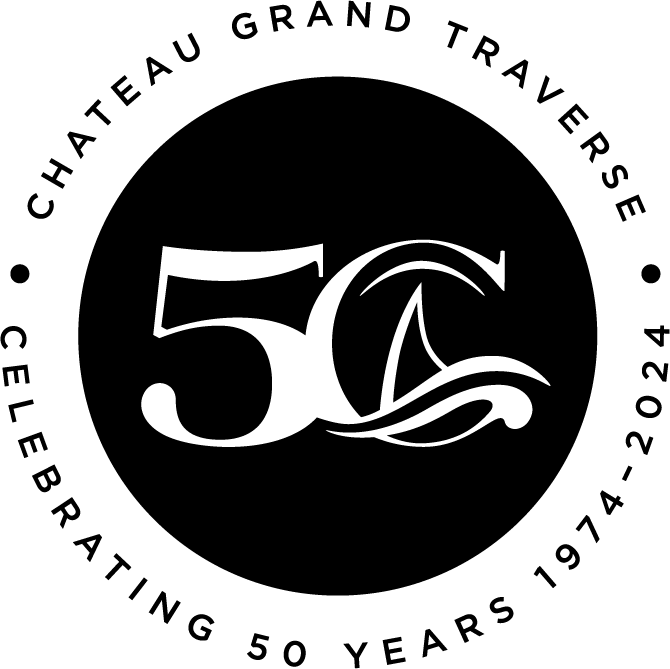40 Years: A Look Back
This year Chateau Grand Traverse celebrates their 40th Anniversary. Since 1978 when founder Edward O’Keefe harvested his first commercial crop, the number of vineyards in the region has grown exponentially. Grape cultivation and wine production has developed an entire industry that was nearly nonexistent in the area forty years ago. Today, over thirty wineries exist between the Leelanau & Old Mission Peninsulas and the wines they produce are starting to gain recognition worldwide.
As a natural entrepreneur, O’Keefe’s assorted background brought him to Europe on numerous occasions. During that time, he developed a fascination for the region and a passion for the wine crafted from European vinifera grapes. This species of grape, including varieties such as Riesling, Chardonnay, Pinot Noir Merlot and others, has been cultivated for thousands of years because the distinct qualities of its varietals compose the majority of the most noted wines produced around the world.
Based upon knowledge he gained, O’Keefe was determined to grow high-quality European vinifera grapes for wine. He had considered both California and Germany as potential locations for his vineyards, but instead landed in the yet-undeveloped viticulture region of Northwest Michigan. Noting that the fruit production near his summer home in Williamsburg, Michigan seemed to be a promising location O’Keefe brought together noted professionals for consultation and research.
“All the factors seemed to add up on Old Mission Peninsula: high elevation, tempering effects from water, and southwest exposure” explains the founder’s son Eddie O’Keefe. However, the climate was not considered viable due to the harsh winter temperatures. “It was simply deemed too cold, and the European vines couldn’t survive in such low temperatures for a long period of time.”
In the 1970’s, Northwest Michigan’s viticulture was purely focused on growing French/American hybrid grape varieties. These hybrids were winter hearty and produced fruit in harsh conditions but with a consequently different flavor profile. At the time, Bernie Rink of Boskydel Vineyards & Larry Mawby were among those exploring wine production with hybrid grapes. However, research concerning the growth of vinifera in Northwest Michigan was virtually non-existent and thus the outcome was entirely unknown.
Dr. Helmut Becker, known as the ‘Johnny Appleseed of Riesling’ traveled from Germany to visit with O’Keefe and assist in planting a research vineyard on Old Mission Peninsula.
“He saw all the cherries, peaches and apricots, the surrounding water, and thought it could be a great location to grow Riesling,” says Sean O’Keefe, Ed’s youngest son. “Peaches are a tender fruit, and Riesling is typically more cold hearty. They [O’Keefe & Dr. Becker] believed it could work”
Dr. Stan Howell of Michigan State University specializes in cold-weather viticulture. He stood among the many academics and professionals that cautioned O’Keefe not to invest. “My responsibility was not to jump on the bandwagon, but to critically assess the information at hand,” Dr. Howell reflects. Many people were very skeptical of the vinifera varietals likelihood to survive through the cold winters of Northern Michigan.
“Commonly accepted data suggests if the temperature falls below -9 degrees the most fruitful primary buds of vinifera varietals are almost entirely wiped out,” says Craig Cunningham, the owner a local vineyard management business. “No doubt about it, the chance that was taken was a 50/50 flip of a coin.”
Despite the overwhelming skepticism O’Keefe believed in the region’s potential. He moved over a million cubic yards of soil to develop the perfect site with the ideal southwest slopes and in 1975 he planted 30 acres of Riesling and Chardonnay grapes. O’Keefe had his first commercial harvest in 1978— the vines had survived and even produced fruit, proving it was possible to grow vinifera grapes on a commercial scale in Northern Michigan.
The mesoclimates of the Old Mission & Leelanau Peninsulas are unique to this area. The surrounding lake creates a moderating effect on the weather, producing a protective, less extreme climate on nearby land. The water warmed throughout the summer season keeps air temperatures higher in the fall and winter. While remaining cold in the spring, the water helps to slow down bud break, reducing the chance of bud damage from spring frosts.
In Northern Michigan, growing fruit in general is a risky proposition. While we learn more and more every year, success is always based at the whim of Mother Nature. Even still, the wine industry has transformed Northwest Michigan over the last forty years. You’ll find the evidence not only in the local economy and growing number of tourists, but in the expansive vineyards covering hundreds of acres across the Peninsulas.
O’Keefe’s sons, Sean & Eddie, are both heavily invested in the future of Chateau Grand Traverse. They remark with pride and appreciation for their quirky, passionate father; a man who took very big risks to follow his dreams. Chateau Grand Traverse now celebrates 40 years, and with it, the successful growth of vinifera grapes in Northern Michigan.
“No one could be more delighted for Ed to be right,” reflected O’Keefe’s original skeptic Dr. Stan Howell. “Individual entrepreneurs like Mr. O’Keefe need to be recognized for their pioneering efforts.”
Ed O’Keefe’s commitment to vinifera, despite all the risks, had an impact on the Northwest Michigan wine region as a whole. One could entertain that some risks aren’t worth taking, but those with passion and determination behind them often precede greatness. Where would we be without those people that push boundaries and dream of the unimaginable? The vineyards that have helped define the Northwest Michigan landscape over the last forty years may not have been possible without such a pioneer.
See an abbreviated version here.




